
|
May 30th, 2012
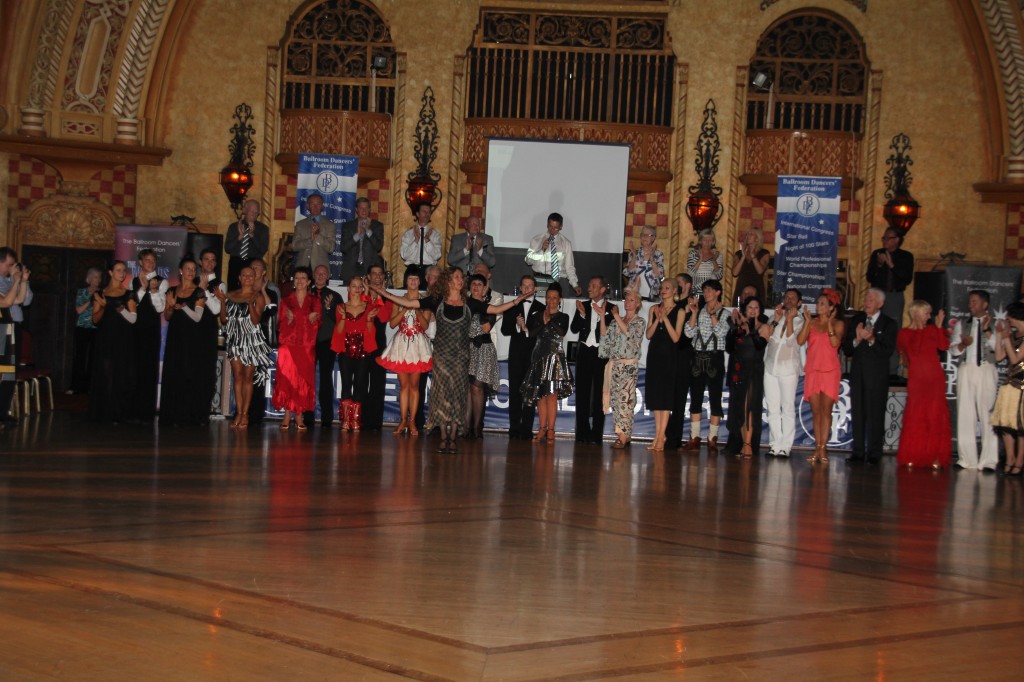
We have maybe heard about it from our coaches or we have put our own efforts in and researched the history of our ballroom dances and how they came about, but this year Brigitt Mayer, author of Ballroom Icons has pulled it all together into one entertaining and informative history “show”
It was conducted in the Spanish Hall of the Winter Gardens in Blackpool as part of the BDF congress during this years British Dance Festival. Spontaneous standing ovations were received throughout the presentation and spectators said they had “tears in their eyes”. Part of the huge success was a well structured power-point presentation but in particular the dance numbers presented by an all star cast of over 10 world champions going as far back as 1962.
Dances of historical significance were presented, some video clips shown, but the highlights were the original choreography’s from the first superstars of Ballroom dancing.
We all certainly learned one thing: history does not have to be dry!
Posted in Book | No Comments Yet »
April 14th, 2012
The Historical Committee and Educational Department are happy to announce: 
The DanceArchives website is up and running!
This is an ongoing project and does not claim completeness (- ever:)).
We concentrated on organizing the facebook articles and structuring the page, so the public can find things easily.
In the near future, besides continuing with this, we will work on the results section, influential people of the past, historical events, national histories… Lots of pictures need to be gathered, uploaded and described and the same with video material. In that we rely on lovers of this art form who have maybe gathered pictures, lecture notes film material etc. and send them to us for filing. Feel free to contact me.
So come and check it out and spread the word!
Brigitt Mayer, George Pytlik and Ruud Vermeij
http://www.dancearchives.net/
Posted in Book | No Comments Yet »
February 15th, 2012

We are pleased to let you know that the new website is almost ready to launch. We will keep you posted and share the link as soon as it is up.
This new site has multiple purposes;
- We will gather information, pictures, scans and film/video/YouTube materials of the historical development related to our dance form and have it in chronological order. It is meant not only for you, the dancers, teachers and coaches on this platform, but also the public outside the inner circles; i.e. journalists and media, students and scholars for research etc.. Our senior advisors will help in determining authenticity and chronological order as well as submit articles on their “points of view”.
- The Educational Department will continue to post their articles on Facebook but also on this new DanceArchives site, for easy sharing and “filing” of articles, so that it can be found fast at a later point in time.
- That is possible since the different posts/articles will have different “tags” i.e. authors name, dates, subject, i.e. music, dances, decade and many more.
We will keep you posted on the launch and the use of this
site!
Brigitt Mayer-Karakis
Posted in Book, Events | No Comments Yet »
January 18th, 2012
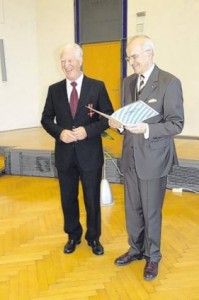 German professional ballroom dance phenomenon Rudolf Trautz recieved the German Cross of Merit in a festive ceremony last week. German professional ballroom dance phenomenon Rudolf Trautz recieved the German Cross of Merit in a festive ceremony last week.
Will anyone in his country hold as many titles ever again? — Probably not.
His influence at the time was immense, particularly on the Latin dance style, which was still evolving. In 1964, he and his wife at the time Mechtild left home, job and security to pursue their passion.
Dance! Congratulations!!!
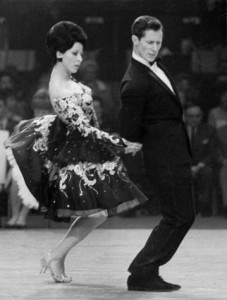 dancing paso doble around 1969
Posted in Book | No Comments Yet »
December 5th, 2011
Ragtime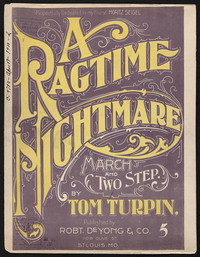
Before we can go into the swing we need to look a bit further back and just briefly check out the rag/ragtime since a lot changed with that music style!
Ragtime was composed for solo piano. A lot of inspiration was taken from marches and other European musical forms; It’s basically a derivative of dance music of the 1890s, such as the cakewalk (so named because the best dancers would win a cake) and owed its building blocks and “oom-pah” bass figures to European music like the mazurka and polka. Ragtime influenced later the growth of the stride and boogie piano styles, but ragtime itself was not yet jazz. It is a musical genre which main trait is its “ragged” i.e. syncopated  rhythms. It supposedly has its origin in the red-light districts of New Orleans and St Louis area and is a distinctly American musical style. It has European influences from the popular music over there at the time and fused it with rhythms from the African-Americans. Here one piece that we probably all know from Scott Joplin (1868–1917) “The Entertainer” from 1902. rhythms. It supposedly has its origin in the red-light districts of New Orleans and St Louis area and is a distinctly American musical style. It has European influences from the popular music over there at the time and fused it with rhythms from the African-Americans. Here one piece that we probably all know from Scott Joplin (1868–1917) “The Entertainer” from 1902.
http://www.youtube.com/watch?v=fPmruHc4S9Q
Before the rag, Paris/Europe had the biggest influence on dancing, but from then on until after the First World War, New York was the leading authority. I am not talking about our ballroom dancing now, but western partner dancing in general.
Part II merging into Charleston and the “roaring 20s” (USA)
The 1920s are often referred to as “The Jazz Age”, and considered the first truly modern decade. Everything was seemingly done to excess The first dances coming from out of this time period with new rhythms i.e. syncopations, were the Grizzly Bear, Turkey Trot, Bunny Hop and then the One-Step. For more info and some examples go to
http://www.youtube.com/watch?v=SclJ94h2oyQ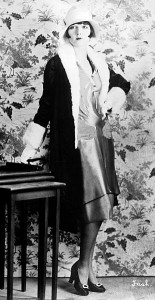
Out of this ragtime-jazz period also the Charleston established. Although the origins of the dance are obscure, the dance has been traced back to African-Americans who lived on an island off the coast of Charleston, South Carolina (which is why the dance is called “Charleston”) and was originally a solo dance http://www.youtube.com/watch?v=s58iTzznkp0&feature=fvwrel The Charleston dance had been performed in black communities since 1903, but did not become internationally popular until the debut of James P. Johnsons Broadway musical Runnin’ Wild
in 1923. (In this clip here you can see movements that resemble movements of the Lindy-Hop from the later swing period.)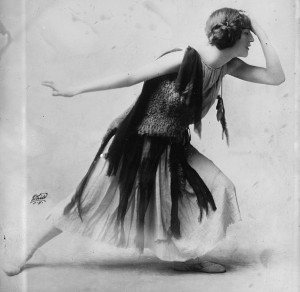
It’s all a quite intriguing, complex development; a lot was going on in that period world-wide on a political and social level. In America a new woman was born in the 20’; she smoked, drank danced and voted. She cut her hair, wore make-up, went to parties was giddy and took risks. She was a flapper! The term “flapper” first appeared in Great Britain after World War I. It described young girls, still awkward in movement, who had not yet entered womanhood. http://www.youtube.com/watch?v=yNAOHtmy4j0&feature=related
Part III merging into the Swing period
By the end of the 1920s and the dawn of the 1930s, a new musical sound was on the horizon, and the Swing Era was eventually ushered in. There is a whole huge musical excursion possible in order to explore jazz, but that’s not the place here. I will just go into a short stroll of the swing era and the related dances that emerged.
The term “swing” is a very general term and can describe several different things.
Among these, swing can refer to:
- a syncopated rhythm that is a common characteristic of jazz music
- a style of jazz music known as “swing jazz,” and often incorrectly termed as “big band” music
- a related variety of dances which includes Lindy Hop, West Coast Swing, and Smooth Lindy
- a few varieties of music that it is very common to swing dance to
- Jazz music was a style of American music most popular in the 1930s and early 1940s.
- Swing jazz features the syncopated timing associated with African American and West
African music and dance — a combination of quarter notes and eighth notes (crotchets and quavers) that the swing dancers interpret as ‘triple steps’ and ‘steps’ — yet also introduces changes in the way these rhythms were played — a distinct delay or ‘relaxed’ approach to timing.
Just a small glimpse into the musical aspect here:
“It don’t mean a thing if it ain’t got that swing.” What Duke Ellington was referring to in that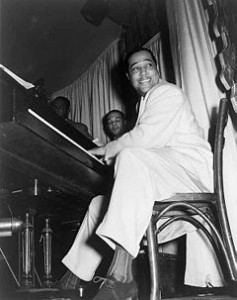 song was the rhythm of the music. This is where syncopation comes in. A simple idea of syncopation is the thought of a ‘rhythmic surprise’. This can be done by accenting certain notes or by unevenly timing the beats. Both jazz and ragtime make use of syncopation; the name of ragtime music itself comes from its uneven or “ragged timing” as mentioned above. song was the rhythm of the music. This is where syncopation comes in. A simple idea of syncopation is the thought of a ‘rhythmic surprise’. This can be done by accenting certain notes or by unevenly timing the beats. Both jazz and ragtime make use of syncopation; the name of ragtime music itself comes from its uneven or “ragged timing” as mentioned above.
When music is played as it is written on the page, musicians refer to it as being played “straight”, or “unswung”. Meaning if what is written on the page of music are 8th notes, and you play those notes as perfectly timed 8th notes — each having the same duration of time — then you are playing the music “straight”.
When it comes to swing, music and syncopation, swing refers to the creation of the feel of a forward momentum, by dividing each beat into a pair of 8th notes, but playing the first slightly longer than an 8th and then playing the second slightly shorter than an 8th, or vice versa. It is described often as the first note “stealing” some of the second note’s time so that they are of unequal duration: swing timing. Another way the music is “swung” is by playing just a fraction of a beat ahead of the actual beat thus giving the music as a whole a feel of this before mentioned forward momentum. On the other hand, playing just behind or slightly after the beat can give the music a relaxed feel.
The dances
Swing jazz music conquered the American social world and there was no country club, ballroom, night club or movie, which was not filled with it. The softer, sweeter tunes were used to foxtrot to and the faster hot ones were used for Lindy Hop.
Lindy Hop is considered to be the first official swing dance; a bold and joyful social dance, with a style that reflects the music. Partners are connected gently to each other, while relating to the music in feeling, improvisation and phrasing. The tempo of the dance can range anywhere from a slow 60 beats per minute, to a frantic 450 beats.
Just as Jazz combines European and African musical origins, the Lindy Hop incorporates African rhythms and styling, European partnering elements, and a wholly American-created partner breakaway to create a unique American dance form done to American music: Hot Jazz, Swing Jazz and Jump Blues. It is a mostly 8 count dance which evolved along side with the new Swing Jazz music, and was based on a mixing of earlier dances such as the Breakaway (the precursor to Lindy Hop) and the Charleston.
The Lindy Hop developed in Harlem, New York, whenever people were partying… But only after the opening of the Savoy Ballroom the Lindy Hop got its name and found a home.
Excerpts from the PBS homepage on the Savoy Ballroom: “The Savoy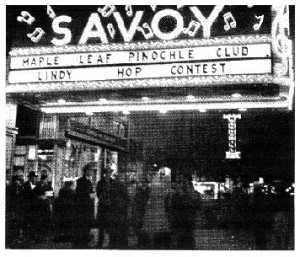 Ballroom was opened on March 12, 1926 by Moe Gale (Moses Galewski), Charles Galewski, and a Harlem real estate businessman called Charles Buchanan, who functioned as the ballroom’s manager. The Savoy was billed as the world’s most beautiful ballroom; it occupied the second floor of a building that extended along the whole block between 140th and 141st streets, and featured a large dance floor (200 feet by 50 feet), two bandstands, and a retractable stage. It swiftly became the most popular dance venue in Harlem, and many of the jazz dance crazes of the 1920s and 1930s originated there; it enjoyed a long and glittering career that lasted well into the 1950s, before a decline in its fortunes set in. Ballroom was opened on March 12, 1926 by Moe Gale (Moses Galewski), Charles Galewski, and a Harlem real estate businessman called Charles Buchanan, who functioned as the ballroom’s manager. The Savoy was billed as the world’s most beautiful ballroom; it occupied the second floor of a building that extended along the whole block between 140th and 141st streets, and featured a large dance floor (200 feet by 50 feet), two bandstands, and a retractable stage. It swiftly became the most popular dance venue in Harlem, and many of the jazz dance crazes of the 1920s and 1930s originated there; it enjoyed a long and glittering career that lasted well into the 1950s, before a decline in its fortunes set in.
On its opening night the Savoy featured Fess Williams and his Royal Flush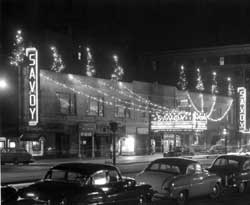 Orchestra, the Charleston Bearcats, fronted by Leon Abbey, and, as a guest band, Fletcher Henderson’s Roseland Orchestra; the Charleston Bearcats formed a lasting connection with the venue and later changed its name to the Savoy Bearcats. Except on special occasions, the ballroom engaged two bands, which played alternate sets, and this policy led to its becoming a famous venue for battles of bands. Elaborate events of this kind were also organized by the management: on May 15, 1927 the Savoy presented a “Battle of Jazz,” which featured King Oliver’s Dixie Syncopators, a band led by Williams, Chick Webb’s Harlem Stompers, and Henderson’s Roseland Orchestra; other battles were fought between bands led by Lloyd Scott, Webb, Alex Johnson, Charlie Johnson, Williams, and Henderson (May 6, 1928) and between Cab Calloway’s Missourians and groups led by Duke Ellington, Henderson, Cecil Scott, Lockwood Lewis, and Webb (May 14, 1930).” Orchestra, the Charleston Bearcats, fronted by Leon Abbey, and, as a guest band, Fletcher Henderson’s Roseland Orchestra; the Charleston Bearcats formed a lasting connection with the venue and later changed its name to the Savoy Bearcats. Except on special occasions, the ballroom engaged two bands, which played alternate sets, and this policy led to its becoming a famous venue for battles of bands. Elaborate events of this kind were also organized by the management: on May 15, 1927 the Savoy presented a “Battle of Jazz,” which featured King Oliver’s Dixie Syncopators, a band led by Williams, Chick Webb’s Harlem Stompers, and Henderson’s Roseland Orchestra; other battles were fought between bands led by Lloyd Scott, Webb, Alex Johnson, Charlie Johnson, Williams, and Henderson (May 6, 1928) and between Cab Calloway’s Missourians and groups led by Duke Ellington, Henderson, Cecil Scott, Lockwood Lewis, and Webb (May 14, 1930).”
1928 Savoy Ballroom dance star “Shorty” George Snowden coined the name Lindy Hop during a dance marathon. Quote: “A spontaneous throw-out breakaway, and a flash footwork improv,
captured media attention.”What are you doing with your feet?” asked the Fox Movie Tone News interviewer. “The Lindy Hop,” replied Shorty George — Charles A. Lindbergh (aka “Lindy”) had recently “hopped” the Atlantic, landing on May 21, 1927. From Shorty George’s
ad hoc reply, the Lindy Hop was officially given a name.
“’Jitter’ was the Jazz culture slang for alcohol, and thus a ‘Jitterbug’ was a term for those who drank a lot of alcohol. However, in the mid 1930’s, the Lindy Hop started to be called the
Jitterbug when the band leader Cab Calloway introduced a bouncy six beat tune in 1934 entitled ‘Jitterbug.’”
Probably the most famous exponent of the Lindy Hop were Frankie Manning He became a member of the White’s Lindy Hoppers in the mid 30’. The troupe was named after the Savoy’s head bouncer Herbert White and they were featured dancers in the movies: “A Day at the Races” (1937 a Marx Brothers movie), “Hellzapoppin” (1941), “Sugar Hill Masquarade (1942) and “Killer Diller” (1948). When Frankie “Muscelhead” Manning created the first air step (aerial) in 1935, the Lindy Hop really “took of”. It became a worldwide craze as the Jitterbug and branched into West Coast Swing, Rock’n Roll and Boogie Woogie. But still today the authentic style is the Savoy Style from Harlem, New York. and “Killer Diller” (1948). When Frankie “Muscelhead” Manning created the first air step (aerial) in 1935, the Lindy Hop really “took of”. It became a worldwide craze as the Jitterbug and branched into West Coast Swing, Rock’n Roll and Boogie Woogie. But still today the authentic style is the Savoy Style from Harlem, New York.
It is often said that Lindy is a strict 8 count dance, but Frankie Manning, who died 2009 age 94 has indicated many times that Lindy is a mixture of various 8, 6, 4 and ten count moves and that “it’s not the timing of the movements that’s important; it’s the feel that counts.”
When we look at the development here we cannot leave the subject of racism and segregation out. The music and the dances came from African Americans and again its complex. Racism and segregation were present. Due to this phenomenon found in many states, clubs throughout the country were often segregated. Just a few bands were racially mixed, of which Benny Goodman’s was possibly the first.
Quote: ”Hollywood films handled the race issue by including the African-American swing jazz band performances in films in such a way that these sections could be easily removed from the movie reels that were to be distributed to Southern states without disturbing the storyline. In these movies, scenes that featured black swing dancers — such as Whitey’s Lindy Hoppers, or the Congoroos — would be completely cut out when they were distributed for Southern audiences. This also had the advantage in that these sections could also be viewed separately from the movie, presenting them as short subject films.”
(Watch this related video on YouTube…it is fabulous…first the Congoroos and then the Whitey’s Lindy Hoppers from the movie Hellzapoppin’ (1941) http://www.youtube.com/watchv=R0BHxhUnokU )
Today in many scenes outside the United States the term “Swing dancing” is used generically to refer to one or all of the following swing era dances: Lindy Hop, Charleston, Shag, and Balboa. This group is often extended to include West Coast Swing, East Coast Swing, Hand Dancing, Jive, Rock and Roll, Modern Jive, and other dances that developed in the 1940s and later.
© Brigitt Mayer
Posted in Book, Uncategorized, Website | No Comments Yet »
October 13th, 2011
© Original Text from Ballroom Icons by Brigitt Mayer
The goddess of dance – beautiful, elegant, regal, warm and generous, and a lady with immense energy; this is how her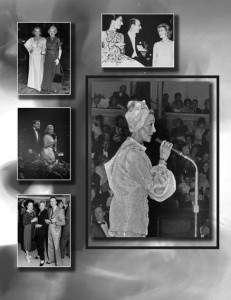
contemporaries described Elsa Wells. She “gave birth” to one of England’s largest championships which has been running since 1953, The International at London’s Royal Albert Hall. She was one of the great female coaches of her timewho “felt like a second skin” when dancing with her students. Elsa Wells was a successful amateur. Dancing with her brother John Wells, they won London’s most prestigious event of that era, the Star Championship, supported by the Star newspaper from 1925 to 1931. In 1938 the event was resumed, and the British Dancers Federation runs it today. However, it never reached its former level of prestige again. In the early 1930s, Elsa turned professional and started dancing with James Barrel, who later changed his name to James Holland, and came second in the Star Professional Championship to Timothy Palmer and Ella Spowart. Like all dancers of that time, Elsa and James became very innovative and created new patterns in different dances. It is said that some of the crackerjack movements in the quickstep came from them and in the tango they started the “zapateado” heel beats that they borrowed from flamenco dancing. James died young after the Second World War, and Elsa never competed again. Experts say there’s no doubt they would have continued to be highly successful competitors, but it wasn’t meant to be. Elsa started to teach and ran a studio in Bayswater, London, and then married Lavy Bakstansky. In 1952, Elsa had the idea of starting a new championship in London. Lavy and Lyndon Wainwright, an early Latin pioneer, became part of the organizing committee. Lavy’s connections with a Jewish fraternity proved beneficial both for the planned event, called The International, and the ballroom dancing world as a whole. The idea at that time was to collect money for Israel and hold the event together with the Jewish Observer newspaper at Royal Albert Hall on behalf of several charities. Elsa continued to work with couples and became one of the most sought after coaches. Colleagues and critics praised her for her elegant style and students and pupils praised her for her ability to become like “a second skin” for her male pupils. The female pupils were observers and learned mostly by watching, which at the time was
standard practice.
Laurie Yates, a fellow of the Imperial Society of Teachers of Dancing remembers,
“Elsa Wells was my ballroom coach when I was a junior competitor. I remember well my first lesson with her when I was 13 years old. My partner and I arrived with my parents, and while waiting in the foyer we heard this very deep woman’s voice saying to the couple she was teaching in the next room, ‘Excuse me one moment, my next victims have arrived.’ As we shook in our boots, she came out looking as she always did, like the reincarnation of Marlene Dietrich with a ‘head turning’ air of superiority, elegance and beauty.
“She was dressed, as always in a plain black silk blouse and black trousers with black leather Cuban heeled shoes, which although worn today by most ballroom women for teaching, looked very unusual at that time. She proceeded to advise us of the ‘procedure’ that we must remember
when we arrived in future, which was that we should walk through the studio and sit in the armchairs on the ‘step-high’ stage, at which point she would draw the curtains.
“During lessons, the parents sat on this stage with the curtains drawn, and periodically Elsa would open them so we could demonstrate a new group or some improvement we had made. At one side of the studio she always had a small table on which stood a china teacup and saucer. Frequently during the lesson, she would take sips. We later discovered that the teacup contained gin, which probably explains why she wore such heavy perfumes. One rather nice touch she had was that she always introduced the previous couple she had taught to her next lesson by saying, ‘Do you know x & y?’ Then usually she would add, ‘I’m very pleased with them.’ The whole experience was something of an age gone by, even at that time. A bit like a scene out of a Noel Coward play or a Merchant Ivory film.”
In 1971, after Lavy’s death, Elsa appointed Albert Rudge as her organizer, and in 1976, Bobby Short, who ran it until his death in 2002. Today The International is organized by John Leach, editor of Dance News, on behalf of Dance News Special Projects Ltd. (Chairwoman Linda Short). The supported charity for the last 20 years is The British Polio Fellowship.
Brigitt Mayer, Canada, author of Ballroom Icons©
All rights reserved. No part of this book/piece may be reproduced in
any form, by print, microfilm or any other means without written permission
from the author.
Posted in Book, Events, Icons | 1 Comment »
May 26th, 2011
…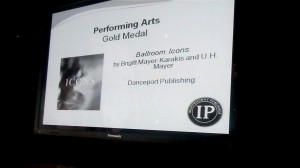 Brigitt Mayer-Karakis and U.H. Mayer for Ballroom Icons. Brigitt Mayer-Karakis and U.H. Mayer for Ballroom Icons.
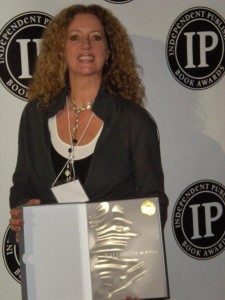
For 15 years, the Independent Book Publisher’s Awards, or IPPY Awards, have recognized the deserving but often unsung titles published by independent authors and publishers, and bring them to the attention of booksellers, buyers, librarians, and book lovers around the world. For the 2011 awards, some 4,000 entries in a number of categories were judged on content, originality, design, and production quality, with emphasis on innovation and social relevance.
We’re excited to announce that Ballroom Icons has won the prestigious Gold Medal in the category of Performing Arts at the 2011 IPPY Awards.
Awards Director Jim Barnes says, “Independent publishers are the truth tellers. Readers respond to books prepared with honesty and creativity. These are the books that win our awards and these are the books that make a difference.” The IPPY Awards are known for recognizing excellence in a broad range of subjects.
Describing the judging process, Barnes explains, “The authors’ dedication to truth and the art of literature makes these awards worthwhile and inspires us to delve into the massive task of judging each year. If you appreciate books written from the heart, not the wallet, and dedicated to truth, not profit, check out IPPY Award-winning books – they deserve your attention and admiration.”
As an award winner, Ballroom Icons is authorized to display the Gold IPPY seal on the book and in marketing materials, helping to bring greater attention to the literary value of this work. Many book buyers make their purchasing decision based on this award, so this award is a significant step in bringing more attention worldwide to Ballroom
Posted in Book | No Comments Yet »
May 22nd, 2011
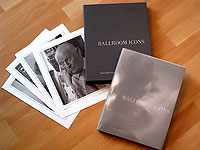 Blackpool is just around the corner, so don’t forget: DanceSport International (DSI) carries Ballroom Icons at a special price at there booth. Blackpool is just around the corner, so don’t forget: DanceSport International (DSI) carries Ballroom Icons at a special price at there booth.
If you did not have a chance to look inside the book yet; there you can!
Also, DSI is our wholesale distributor for the continent. European vendors interested in carrying the book should contact DSI and speak to Malcolm Hearn.
Now enjoy another Britsh Open Dance Festival
Posted in Book | No Comments Yet »
May 20th, 2011
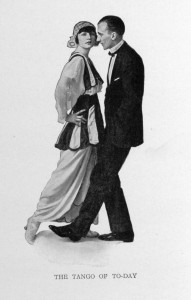 Photograph of Irene and Vernon Castle posed as instruction for dancing their version of the tango. From their 1914 book “Modern Dancing” published by The World Syndicate Co. by arrangement with Harper & Brothers. Excerpts from Ballroom Icons:
“…Vernon and Iren Castle were the first big international exponents of “modern dancing”. The Castle Walk is named after them and they helped to popularize the Foxtrot, Hesitation Waltz, Maxixe and the Tango. At Castle House they taught New York society the latest dance steps by day, and greeted guests and performed at their clubs by night….They were instrumental in launching the ballroom dance “craze” of the 1920s, taught private lessons and appeared at fashionable parties. They were just “IT”!”
“…Vernon and Irene Castle were far more famous and influential in their day than Fred Astaire and Ginger Rogers were later, though they are less remembered now. …”
See related video: http://www.youtube.com/watch?v=j5TE74e9vAg&feature=related
“… Although his mentors, Vernon and Irene Castle, were primarily responsible for launching the ballroom dance “craze” in the 1920s, Arthur and Kartryn Murray were instrumental in keeping it going through the Great Depression, the Second World War and the disco era.…
“…Of particular historical interest is Arthur’s innovative approach to “this dance business” and how to advertise dance lessons. He was first to do many groundbreaking things like broadcasting live music, creating infomercials, franchising, and starting mail-order dance lessons. Chances are, if you conducted a poll today, most people would know the name Arthur Murray…”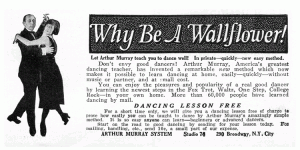
See related video: http://www.youtube.com/watch?v=wxZ2TjMuxTo&feature=share
Brigitt Mayer, Canada, author of Ballroom Icons©
Posted in Book | No Comments Yet »
May 5th, 2011
 For 15 years, the Independent Book Publisher’s Awards, or IPPY Awards, have recognized the deserving but often unsung titles published by independent authors and publishers, and bring them to the attention of booksellers, buyers, librarians, and book lovers around the world. For the 2011 awards, some 4,000 entries in a number of categories were judged on content, originality, design, and production quality, with emphasis on innovation and social relevance. For 15 years, the Independent Book Publisher’s Awards, or IPPY Awards, have recognized the deserving but often unsung titles published by independent authors and publishers, and bring them to the attention of booksellers, buyers, librarians, and book lovers around the world. For the 2011 awards, some 4,000 entries in a number of categories were judged on content, originality, design, and production quality, with emphasis on innovation and social relevance.
We’re excited to announce that Ballroom Icons has won the prestigious Gold Medal in the category of Performing Arts at the 2011 IPPY Awards.
Awards Director Jim Barnes says, “Independent publishers are the truth tellers. Readers respond to books prepared with honesty and creativity. These are the books that win our awards and these are the books that make a difference.” The IPPY Awards are known for recognizing excellence in a broad range of subjects.
Describing the judging process, Barnes explains, “The authors’ dedication to truth and the art of literature makes these awards worthwhile and inspires us to delve into the massive task of judging each year. If you appreciate books written from the heart, not the wallet, and dedicated to truth, not profit, check out IPPY Award-winning books – they deserve your attention and admiration.”
As an award winner, Ballroom Icons is authorized to display the Gold IPPY seal on the book and in marketing materials, helping to bring greater attention to the literary value of this work. Many book buyers make their purchasing decision based on this award, so this award is a significant step in bringing more attention worldwide to Ballroom Icons.
Posted in Book | 1 Comment »
|


 For 15 years, the Independent Book Publisher’s Awards, or IPPY Awards, have recognized the deserving but often unsung titles published by independent authors and publishers, and bring them to the attention of booksellers, buyers, librarians, and book lovers around the world. For the 2011 awards, some 4,000 entries in a number of categories were judged on content, originality, design, and production quality, with emphasis on innovation and social relevance.
For 15 years, the Independent Book Publisher’s Awards, or IPPY Awards, have recognized the deserving but often unsung titles published by independent authors and publishers, and bring them to the attention of booksellers, buyers, librarians, and book lovers around the world. For the 2011 awards, some 4,000 entries in a number of categories were judged on content, originality, design, and production quality, with emphasis on innovation and social relevance.